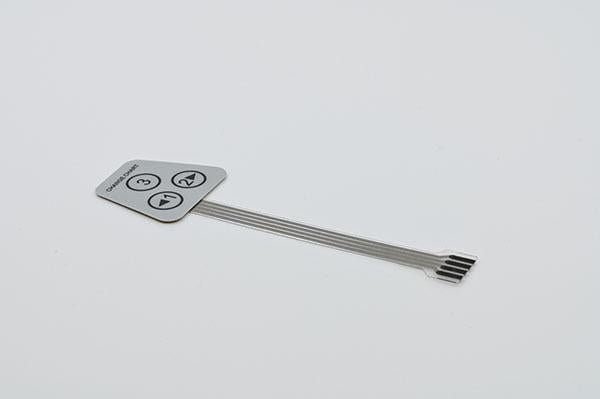Understanding the Functionality of Membrane Switches Over for Interface Gadget
The performance of membrane layer switches over stands for a significant development in customer interface layout, combining effectiveness with aesthetic convenience. As industries progressively focus on individual experience, recognizing the nuances of membrane switch technology ends up being important.
What Are Membrane Layer Switches?
Membrane switches are cutting-edge user interface devices that help with customer interaction with digital equipment. These functional components contain numerous layers, consisting of a visuals overlay, spacer, and a printed circuit layer. The layout enables a seamless combination right into various electronic tools, improving both the visual and practical elements of individual interfaces.
Membrane buttons are typically used in a variety of applications, from family devices to industrial equipment and clinical tools. Their building typically includes a slim profile, making them an ideal option for compact styles. The tactile comments supplied by these buttons can be crafted to fulfill certain user preferences, making sure reliable interaction between the individual and the tool.
Resilience is another considerable advantage of membrane layer buttons, as they are immune to dirt, dampness, and chemicals, which improves their life-span popular settings. In addition, these switches can be customized in terms of shape, dimension, and graphic design, allowing for branding and user-specific attributes. Overall, membrane switches represent a functional remedy for boosting individual experience in electronic gadgets, combining capability with visual charm in a reliable manner.
Just How Membrane Switches Job
Operating on an uncomplicated concept, membrane switches over use a split construction to register individual input effectively. Each button contains numerous layers, consisting of a published circuit layer, a spacer layer, and a leading visuals layer, which are developed to work together perfectly. When an individual presses the top layer, it compresses the spacer layer, bringing the conductive aspects of the circuit layer into contact with each various other.
This contact develops a closed circuit, signaling the tool to execute a particular function. The design enables different setups, including tactile comments, which can improve the customer experience by offering a physical experience upon activation. The materials made use of in membrane layer buttons typically consist of adaptable substratums, such as polyester or polycarbonate, which make certain toughness and durability against wear and tear.

Secret Advantages of Membrane Switches

One more considerable advantage is their density. Membrane layer switches are thin and lightweight, which allows suppliers to conserve space in their tools without sacrificing performance. This function is particularly beneficial in applications where weight and volume are important factors to consider.
Furthermore, membrane layer switches are immune to dirt, wetness, and chemicals, enhancing their longevity. This durability extends their life expectancy and reduces the demand for constant substitutes, resulting in price savings in time.
Moreover, the responsive comments given by membrane layer buttons can be enhanced to boost individual interaction. They can consist of features such as increased buttons or audible clicks, boosting functionality and individual experience.
Applications Throughout Industries
Individual user interface tools utilizing membrane switches are widespread in a wide variety of markets, showcasing their versatility and performance. Membrane Switch. In the clinical industry, membrane switches are indispensable to gadgets such as analysis devices and individual monitoring systems, where their sturdiness and ease of cleaning are important for keeping health requirements. In the automotive market, these buttons are utilized in control panel controls and infomercial systems, supplying a sleek and modern-day interface for individuals.
In addition, the consumer electronics field benefits from membrane layer switches in appliances Check This Out and handheld devices, where small layout and straightforward user interfaces improve individual experience. Industrial applications also leverage membrane changes for control panels in equipment and automation systems, stressing their toughness and resistance to extreme environments.
In the aerospace and defense sectors, membrane layer buttons are made use of in cockpit controls and devices, where integrity and efficiency under severe conditions are paramount. Additionally, the gaming market significantly incorporates membrane switches in controllers and arcade equipments, contributing to an appealing customer experience. Overall, the versatility of membrane changes enables their prevalent usage throughout many markets, emphasizing their relevance in contemporary individual interface design.
Future Trends in Membrane Layer Switch Over Innovation

In addition, using advanced materials, such as polycarbonate and polyester movies, is anticipated to climb, giving boosted longevity and resistance to ecological stress factors. These materials contribute to the overall durability of membrane layer switches, making them appropriate for harsher industrial applications.
In addition, the unification of clever innovation, including IoT connection, will certainly allow membrane layer switches to interact with other tools and systems, promoting a much more interactive user experience. This trend lines up with the expanding need for wise gadgets throughout numerous fields, from healthcare to consumer electronic devices.
Lastly, you could try these out personalization options are anticipated to increase, enabling producers to produce bespoke services customized to details customer requirements and choices. These advancements will certainly position membrane switches as crucial parts in the development of user interface modern technology.
Conclusion
In conclusion, membrane switches represent an essential development in individual interface modern technology, providing a reputable and flexible solution for diverse digital applications. As advancements in material scientific research and touch sensing technologies proceed, the performance and applicability of membrane layer buttons check my reference are anticipated to increase, reinforcing their significance in modern digital tools.